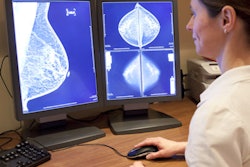
Research published in the literature on mammography computer-aided detection (CAD) software has focused largely on diagnostic accuracy, with very few studies addressing how radiologists use and perceive the technology, according to an article published online July 18 in JMIR Medical Informatics.
After performing a literature review, Rafia Masud and colleagues at McMaster University in Ontario, Canada, found a significant research gap between the number of studies investigating the diagnostic performance of mammography CAD software and those that considered its implementation and use by radiologists. They also found that the cost-effectiveness of CAD for breast cancer screening hasn't been well-established.
"Further research is needed on how to best facilitate CAD in radiology practices in order to optimize patient outcomes, and the views of radiologists need to be better considered when advancing CAD use," the authors wrote.
Mammography CAD has become widely used in breast cancer screening applications. However, its implementation in clinical settings has largely been overlooked in CAD research, explained the authors.
With the ongoing development of machine-learning applications, it's important to understand how technologies such as CAD are implemented and how they impact healthcare providers, according to the researchers. To learn more, they searched the Medline database for peer-reviewed articles published between January 2010 and March 2018 on topics related to barriers or facilitators for CAD implementation.
After reviewing the nine articles that met their inclusion criteria, the researchers found that radiologists' use of mammography CAD is based on tradeoffs between barriers -- less favorable perceptions of CAD by radiologists, increased recall rates, higher costs, and an uncertain effect on patient outcomes -- and facilitators, such as higher CAD uptake due to improved cancer detection rates, increased profitability in some contexts, and time saved from double reading.
"With the increasing prevalence of CAD in mammography practices, especially in the United States, it is important to understand how CAD impacts radiologists, their practice, and the healthcare system," the authors wrote. "Although there is a financial incentive for radiologists to use CAD in the United States, it is still unclear whether better patient outcomes are being achieved. The tradeoffs of implementing CAD in different settings should be considered, especially the cost-effectiveness, as there is a significant investment involved in the transition to CAD."
As a result, the researchers propose that further studies be performed to better understand the adoption and implementation of CAD in clinical environments.
"Specifically, there should be a focus on investigating radiologists' perceptions of CAD use in various settings, as we only came across one such study based in the United States, which cannot be generalized to other settings and health care systems," Masud and colleagues wrote. "In addition, a better understanding of the extent to which CAD is used in different countries and policies that have led to these levels of use can be explored. Lastly, the cost-effectiveness of CAD use for breast cancer screening in various populations should be assessed to determine appropriate thresholds in order to facilitate CAD implementation."


















